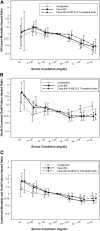Associations of pretransplant weight and muscle mass with mortality in renal transplant recipients
- PMID: 21415312
- PMCID: PMC3109945
- DOI: 10.2215/CJN.09131010
Associations of pretransplant weight and muscle mass with mortality in renal transplant recipients
Abstract
Background and objectives: The association between pretransplant body composition and posttransplant outcomes in renal transplant recipients is unclear. It was hypothesized that in hemodialysis patients higher muscle mass (represented by higher pretransplant serum creatinine level) and larger body size (represented by higher pretransplant body mass index [BMI]) are associated with better posttransplant outcomes.
Design, setting, participants, & measurements: Linking 5-year patient data of a large dialysis organization (DaVita) to the Scientific Registry of Transplant Recipients, 10,090 hemodialysis patients were identified who underwent kidney transplantation from July 2001 to June 2007. Cox regression hazard ratios and 95% confidence intervals of death and/or graft failure were estimated.
Results: Patients were 49 ± 13 years old and included 49% women, 45% diabetics, and 27% African Americans. In Cox models adjusted for case-mix, nutrition-inflammation complex, and transplant-related covariates, the 3-month-averaged postdialysis weight-based pretransplant BMI of 20 to <22 and < 20 kg/m(2), compared with 22 to <25 kg/m(2), showed a nonsignificant trend toward higher combined posttransplant mortality or graft failure, and even weaker associations existed for BMI ≥ 25 kg/m(2). Compared with pretransplant 3-month- averaged serum creatinine of 8 to <10 mg/dl, there was 2.2-fold higher risk of combined death or graft failure with serum creatinine <4 mg/dl, whereas creatinine ≥14 mg/dl exhibited 22% better graft and patient survival.
Conclusions: Pretransplant obesity does not appear to be associated with poor posttransplant outcomes. Larger pretransplant muscle mass, reflected by higher pretransplant serum creatinine level, is associated with greater posttransplant graft and patient survival.
Figures



Comment in
-
Interpreting body composition in kidney transplantation: weighing candidate selection, prognostication, and interventional strategies to optimize health.Clin J Am Soc Nephrol. 2011 Jun;6(6):1238-40. doi: 10.2215/CJN.02510311. Epub 2011 May 12. Clin J Am Soc Nephrol. 2011. PMID: 21566111 No abstract available.
References
-
- Pirsch JD, Armbrust MJ, Knechtle SJ, D'Alessandro AM, Sollinger HW, Heisey DM, Belzer FO: Obesity as a risk factor following renal transplantation. Transplantation 59: 631–633, 1995 - PubMed
-
- Pischon T, Sharma AM: Obesity as a risk factor in renal transplant patients. Nephrol Dial Transplant 16: 14–17, 2001 - PubMed
-
- Ghahramani N, Reeves WB, Hollenbeak C: Association between increased body mass index, calcineurin inhibitor use, and renal graft survival. Exp Clin Transplant 6: 199–202, 2008 - PubMed

